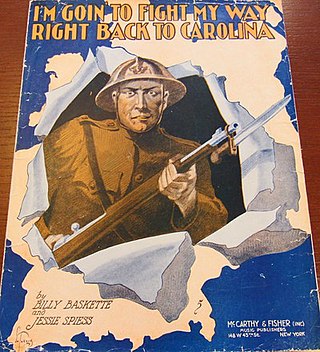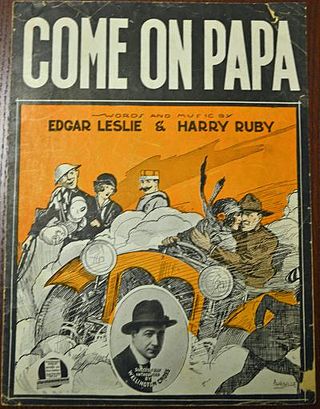
Albert Von Tilzer was an American songwriter, the younger brother of fellow songwriter Harry Von Tilzer. He wrote the music to many hit songs, including, most notably, "Take Me Out to the Ball Game".

Lew Brown was a lyricist for popular songs in the United States. During World War I and the Roaring Twenties, he wrote lyrics for several of the top Tin Pan Alley composers, especially Albert Von Tilzer. Brown was one third of a successful songwriting and music publishing team with Buddy DeSylva and Ray Henderson from 1925 until 1931. Brown also wrote or co-wrote many Broadway shows and Hollywood films. Among his most-popular songs are "Button Up Your Overcoat", "Don't Sit Under the Apple Tree", "Life Is Just a Bowl of Cherries", "That Old Feeling", and "The Birth of the Blues".

Andrew B. Sterling was an American lyricist.
Hitchy-Koo of 1919 is a musical revue with music and lyrics by Cole Porter and a book by George V. Hobart. This revue was third in a series of four Hitchy-Koo Broadway revues from 1917 to 1920 produced by, and starring, Raymond Hitchcock. The revues were named after the 1912 popular song "Hitchy-Koo" by composers Lewis F. Muir and Maurice Abrahams with lyrics by L. Wolfe Gilbert; the only song which was featured in all of the Hitchy-Koo revues. The original Broadway production of this version played in 1919. The revue received favourable reviews.

"Someone Else May Be There While I'm Gone" is a World War I era song written by Irving Berlin and published as sheet music in 1917. The song, recorded by Al Jolson for Columbia Records on September 19, 1916 was very popular that year. Jolson recorded it again for Decca Records on December 5, 1947.

"The Angel God Sent From Heaven" is a World War I era American song published in 1918. Frank L. Ventre composed the music, while Paul A. Smith and Robert Levenson wrote the lyrics. It was published by Jack Mendehlsohn Music Company in Boston, Massachusetts. The song was written for both voice and piano. The cover was illustrated by the Dobinson Engraving Company. On the cover is a drawing of a nurse. Under her picture is a car and soldiers.

"Gee! What a Wonderful Time We'll Have When the Boys Come Home" is a World War I era song released in 1917. Lyrics and music were written by Mary Earl. The song was published by Shapiro, Bernstein & Co. of New York, New York. It was written for both voice and piano. The sheet music cover was designed by artist Albert Wilfred Barbelle. On the cover are soldiers marching down a city street. A skyline is behind them, and the lights spell out, "Welcome Home."

"There's a Green Hill Out in Flanders " is a World War I era song released in 1917. Lyrics and music were written by Allan J. Flynn. Al Piantadosi & Co. of New York City. The song was written for both voice and piano.

"It's a Long, Long Way to the U.S.A " is a World War I era song released in 1917. Val Trainor wrote the lyrics. Harry Von Tilzer composed the music. The song was published by Harry Von Tilzer Publishing Company of New York, New York. It was written for both voice and piano.

"The Little Grey Mother Who Waits All Alone " is a World War I era song released in 1915. Bernard Grossman wrote the lyrics. Harry De Costa composed the music. The song was published by M. Witmark & Sons of New York, New York. Vitagraph actress Mary Maurice is featured on the cover, reading a book and holding a rose. It was written for voice and piano.

"I'm Goin' To Fight My Way Right Back to Carolina" is a World War I era song written and composed by Billy Baskette and Jessie Spiess. The song was published in 1918 by McCarthy & Fisher, Inc. of New York City. The sheet music cover was designed by Andre C. De Takacs. It features an armed soldier tearing through the cover. The song was written for both voice and piano.

"We Don't Want the Bacon (What We Want Is a Piece of the Rhine)" is a World War I–era song released in 1918. The lyrics were written by "Kid" Howard Carr and Harry Russell, and the music composed by Jimmie Havens. The song was published by Shapiro, Bernstein & Co. of New York City. On the cover is a soldier tearing through a large piece of bacon with his bayonet. A fearful-looking Kaiser Wilhelm II is standing on the bacon. It was written for voice and piano.

"Somewhere in France Is Daddy" is a World War I era song released in 1917. Lyrics and music were written by "Great Howard," otherwise known as Howard Miller. It was published by Howard & LaVar Music Co. of New York, New York. There are two versions of the sheet music cover. Both feature a mother holding a child, soldiers firing from a trench, and an inset photo of Great Howard. The latter version is a darker blue and the photo is of Howard in kilts. The song was written for both voice and piano.

"Goodbye, Ma! Goodbye, Pa! Goodbye, Mule, with Yer Old Hee-Haw!", also known as "Long Boy", is a World War I era song released in 1917. William Herschel wrote the lyrics. Barclay Walker composed the music. It was published by Shapiro, Bernstein & Co. of New York, New York. Garr Williams designed the sheet music cover. It features a morose-looking cartoon soldier leaving his farm. Farm animals, the soldier's parents, and his girlfriend look on and wave flags. It was written for both voice and piano.

"It's a Long Way to Berlin, but We'll Get There!" is a World War I era song released in 1917. Arthur Fields wrote the lyrics. Leon Flatow composed the music. Leo Feist, Inc. of New York City published the song. Rosenbaum Studios designed the sheet music cover. It features soldiers marching in formation. There is an inset photo of Maurice Burkhardt, Will J. Ward, Ed Morton, Jimmy Flynn, Willie Weston, or Francis Maguire that varies per edition. There is another version of the cover known as the "Popular edition". It features a photo of Henry Bergman.

"Girls of France" is a World War I era song released in 1917. Al Bryan and Edgar Leslie wrote the lyrics. Harry Ruby composed the music. The song was published by Waterson, Berlin & Snyder Co. of New York, New York. Artist Albert Wilfred Barbelle designed the sheet music cover. It features a nurse in the foreground, and soldiers marching behind her. It was written for both voice and piano.

"Come On Papa" is a World War I era song released in 1918.

Watch, Hope and Wait Little Girl: I'm Coming Back To You is a World War I song written by Lew Brown, and composed by Will Clayton. The song was first published in 1918 by Broadway Music Co. in New York, NY. The sheet music cover was designed by E.E. Walton, and features a young woman in a heart of red, white, and blue, flowers are gathered at her knees

"The Russians Were Rushin', the Yanks Started Yankin'" is a World War I song written by Carey Morgan and composed by Charles R. McCarron. The song was first published in 1918 by Broadway Music Corporation in New York City. The sheet music cover depicts an elderly man smoking a pipe with silhouetted soldiers across the top and bottom.
Hitchy-Koo is a 1912 American popular song and a series of musical revues, inspired by the song, staged on Broadway each year from 1917 through 1920 and on tour in 1922.


















